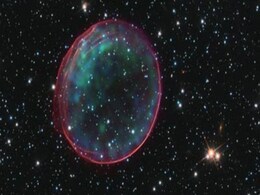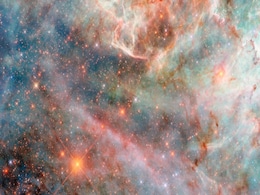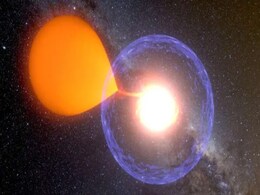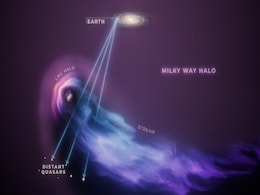Large Magellanic Cloud
- All
- News
-

For The First Time, Scientists Spot Life's Essentials Frozen In A Distant Galaxy
- Saturday October 25, 2025
- Science |
Scientists have discovered complex organic molecules, including acetic acid and ethanol, frozen in ice beyond the Milky Way, suggesting that life's chemical ingredients may be widespread across the universe.
-
 www.ndtv.com
www.ndtv.com
-

Hubble Uncovers Multi-Age Stars in Ancient Cluster, Reshaping Galaxy Origins
- Saturday July 19, 2025
A stunning new image from NASA’s Hubble Space Telescope reveals that ancient star cluster NGC 1786—located 160,000 light-years away in the Large Magellanic Cloud—hosts stars of varying ages. Once believed to contain a single generation of stars, NGC 1786 now appears to preserve a more complex stellar history. This multi-age discovery suggests...
-
 www.gadgets360.com
www.gadgets360.com
-

Astronomers Discover a Gigantic Supernova Remnant in the Large Magellanic Cloud
- Tuesday July 1, 2025
Veliki is a newly discovered, massive supernova remnant in the Large Magellanic Cloud, observed through a global collaboration using multiwavelength astronomy tools. Estimated to be 45,000 years old, Veliki showcases complex shell structures and highly unusual radio properties.
-
 www.gadgets360.com
www.gadgets360.com
-

Hubble Unveils Galactic ‘Cotton Candy’ in the Large Magellanic Cloud
- Sunday June 8, 2025
NASA’s Hubble Space Telescope has captured a breathtaking image of glowing gas and dust in the Large Magellanic Cloud, a dwarf galaxy orbiting the Milky Way. The colorful filaments—nicknamed “galactic cotton candy”—highlight active star-forming regions. Taken with five filters across ultraviolet to infrared wavelengths, the image reveals ...
-
 www.gadgets360.com
www.gadgets360.com
-

Supermassive Black Hole May Be Hiding in Large Magellanic Cloud, Scientists Suggest
- Monday March 10, 2025
A potential supermassive black hole may exist in the Large Magellanic Cloud, as per recent scientific findings. Researchers analysed hypervelocity stars moving at extreme speeds and found many could have been ejected from this neighbouring galaxy. The black hole is estimated to be around 600,000 times the mass of the Sun. If confirmed, this discove...
-
 www.gadgets360.com
www.gadgets360.com
-

Study Reveals Evidence of Supermassive Black Hole Inside Nearby Galaxy
- Friday March 7, 2025
- World News | Reuters
A study based on the trajectory of nine fast-moving stars observed at the fringes of the Milky Way provides strong evidence for the existence of a supermassive black hole inside the Large Magellanic Cloud.
-
 www.ndtv.com
www.ndtv.com
-

Unusual X-ray Flash in Large Magellanic Cloud Puzzles Astronomers
- Tuesday February 25, 2025
A brief yet intense X-ray flash, XRT 200515, was detected in NASA's Chandra telescope data from 2000. The signal, originating from the Large Magellanic Cloud, has left scientists debating its cause. Possible explanations include a neutron star pulling in gas from a companion star or a powerful flare from a distant magnetar. Researchers also specula...
-
 www.gadgets360.com
www.gadgets360.com
-

Scientists Discover Two New Supernova Remnants in a Surprising Location
- Thursday February 13, 2025
Two previously unknown supernova remnants, J0624-6948 and J0614-7251, have been detected in the outskirts of the Large Magellanic Cloud. Their unexpected location suggests a higher-than-expected concentration of ionised gas, raising new questions about galactic evolution. Scientists propose that gravitational interactions between the Milky Way and ...
-
 www.gadgets360.com
www.gadgets360.com
-

Astronomers Spot New Cosmic Explosions 100 Times Brighter Than the Sun
- Wednesday December 25, 2024
Astronomers have discovered a new class of cosmic explosions, known as 'millinovas,' which are 100 times brighter than the Sun. These events, first identified in 2023, were observed in the Large and Small Magellanic Clouds, two satellite galaxies of the Milky Way. The millinovas are thought to occur when white dwarfs feed off a companion star, prod...
-
 www.gadgets360.com
www.gadgets360.com
-

Hubble Telescope Reveals Milky Way Blowing Gas off LMC Galaxy in Close Encounter
- Monday November 18, 2024
NASA’s Hubble Space Telescope has captured an extraordinary phenomenon as the Milky Way galaxy exerts ram pressure on the Large Magellanic Cloud (LMC), stripping away most of its gas halo. The interaction, which occurs as LMC passes near the Milky Way, has led to the loss of significant mass from the dwarf galaxy. Despite this, LMC retains enough...
-
 www.gadgets360.com
www.gadgets360.com
-

NASA’s Hubble Reveals Impact of Milky Way’s Gravitational Force on Large Magellanic Cloud
- Friday November 15, 2024
NASA’s Hubble Space Telescope recently observed the Large Magellanic Cloud (LMC) interacting with the Milky Way’s halo. Researchers found that the LMC’s gas halo has been significantly reduced, likely due to ram-pressure stripping. Despite this, the LMC retains enough gas to continue star formation. Future studies will focus on exploring othe...
-
 www.gadgets360.com
www.gadgets360.com
-

Milky Way and Andromedia Fated Collision Might Not Happen, Reveals New Study
- Sunday August 25, 2024
- Gadgets 360 Staff
Recent research has cast doubt on the certainty of the Milky Way-Andromeda galaxy collision, suggesting the event may not be as inevitable as once thought. Traditionally, astronomers have predicted that our galaxy would merge with Andromeda within the next 5 billion years, creating a new elliptical galaxy often referred to as "Milkomeda." However, ...
-
 www.gadgets360.com
www.gadgets360.com
-

NASA's Hubble Telescope Captures "Candy Floss" Region Of Space. See Pic
- Friday August 23, 2024
- Science |
NASA recently shared a stunning image of a cluster of nebulae called N11, which lies some 160-000 light-years away in the constellation Dorado.
-
 www.ndtv.com
www.ndtv.com
-

Astronomers Discover Rotating Disc Around Star In Neighbouring Galaxy
- Thursday November 30, 2023
- Science |
This event unfolded in the Large Magellanic Cloud, a neighbouring galaxy, within a region known as N180, where numerous new stars are actively taking shape.
-
 www.ndtv.com
www.ndtv.com
-

For The First Time, Scientists Spot Life's Essentials Frozen In A Distant Galaxy
- Saturday October 25, 2025
- Science |
Scientists have discovered complex organic molecules, including acetic acid and ethanol, frozen in ice beyond the Milky Way, suggesting that life's chemical ingredients may be widespread across the universe.
-
 www.ndtv.com
www.ndtv.com
-

Hubble Uncovers Multi-Age Stars in Ancient Cluster, Reshaping Galaxy Origins
- Saturday July 19, 2025
A stunning new image from NASA’s Hubble Space Telescope reveals that ancient star cluster NGC 1786—located 160,000 light-years away in the Large Magellanic Cloud—hosts stars of varying ages. Once believed to contain a single generation of stars, NGC 1786 now appears to preserve a more complex stellar history. This multi-age discovery suggests...
-
 www.gadgets360.com
www.gadgets360.com
-

Astronomers Discover a Gigantic Supernova Remnant in the Large Magellanic Cloud
- Tuesday July 1, 2025
Veliki is a newly discovered, massive supernova remnant in the Large Magellanic Cloud, observed through a global collaboration using multiwavelength astronomy tools. Estimated to be 45,000 years old, Veliki showcases complex shell structures and highly unusual radio properties.
-
 www.gadgets360.com
www.gadgets360.com
-

Hubble Unveils Galactic ‘Cotton Candy’ in the Large Magellanic Cloud
- Sunday June 8, 2025
NASA’s Hubble Space Telescope has captured a breathtaking image of glowing gas and dust in the Large Magellanic Cloud, a dwarf galaxy orbiting the Milky Way. The colorful filaments—nicknamed “galactic cotton candy”—highlight active star-forming regions. Taken with five filters across ultraviolet to infrared wavelengths, the image reveals ...
-
 www.gadgets360.com
www.gadgets360.com
-

Supermassive Black Hole May Be Hiding in Large Magellanic Cloud, Scientists Suggest
- Monday March 10, 2025
A potential supermassive black hole may exist in the Large Magellanic Cloud, as per recent scientific findings. Researchers analysed hypervelocity stars moving at extreme speeds and found many could have been ejected from this neighbouring galaxy. The black hole is estimated to be around 600,000 times the mass of the Sun. If confirmed, this discove...
-
 www.gadgets360.com
www.gadgets360.com
-

Study Reveals Evidence of Supermassive Black Hole Inside Nearby Galaxy
- Friday March 7, 2025
- World News | Reuters
A study based on the trajectory of nine fast-moving stars observed at the fringes of the Milky Way provides strong evidence for the existence of a supermassive black hole inside the Large Magellanic Cloud.
-
 www.ndtv.com
www.ndtv.com
-

Unusual X-ray Flash in Large Magellanic Cloud Puzzles Astronomers
- Tuesday February 25, 2025
A brief yet intense X-ray flash, XRT 200515, was detected in NASA's Chandra telescope data from 2000. The signal, originating from the Large Magellanic Cloud, has left scientists debating its cause. Possible explanations include a neutron star pulling in gas from a companion star or a powerful flare from a distant magnetar. Researchers also specula...
-
 www.gadgets360.com
www.gadgets360.com
-

Scientists Discover Two New Supernova Remnants in a Surprising Location
- Thursday February 13, 2025
Two previously unknown supernova remnants, J0624-6948 and J0614-7251, have been detected in the outskirts of the Large Magellanic Cloud. Their unexpected location suggests a higher-than-expected concentration of ionised gas, raising new questions about galactic evolution. Scientists propose that gravitational interactions between the Milky Way and ...
-
 www.gadgets360.com
www.gadgets360.com
-

Astronomers Spot New Cosmic Explosions 100 Times Brighter Than the Sun
- Wednesday December 25, 2024
Astronomers have discovered a new class of cosmic explosions, known as 'millinovas,' which are 100 times brighter than the Sun. These events, first identified in 2023, were observed in the Large and Small Magellanic Clouds, two satellite galaxies of the Milky Way. The millinovas are thought to occur when white dwarfs feed off a companion star, prod...
-
 www.gadgets360.com
www.gadgets360.com
-

Hubble Telescope Reveals Milky Way Blowing Gas off LMC Galaxy in Close Encounter
- Monday November 18, 2024
NASA’s Hubble Space Telescope has captured an extraordinary phenomenon as the Milky Way galaxy exerts ram pressure on the Large Magellanic Cloud (LMC), stripping away most of its gas halo. The interaction, which occurs as LMC passes near the Milky Way, has led to the loss of significant mass from the dwarf galaxy. Despite this, LMC retains enough...
-
 www.gadgets360.com
www.gadgets360.com
-

NASA’s Hubble Reveals Impact of Milky Way’s Gravitational Force on Large Magellanic Cloud
- Friday November 15, 2024
NASA’s Hubble Space Telescope recently observed the Large Magellanic Cloud (LMC) interacting with the Milky Way’s halo. Researchers found that the LMC’s gas halo has been significantly reduced, likely due to ram-pressure stripping. Despite this, the LMC retains enough gas to continue star formation. Future studies will focus on exploring othe...
-
 www.gadgets360.com
www.gadgets360.com
-

Milky Way and Andromedia Fated Collision Might Not Happen, Reveals New Study
- Sunday August 25, 2024
- Gadgets 360 Staff
Recent research has cast doubt on the certainty of the Milky Way-Andromeda galaxy collision, suggesting the event may not be as inevitable as once thought. Traditionally, astronomers have predicted that our galaxy would merge with Andromeda within the next 5 billion years, creating a new elliptical galaxy often referred to as "Milkomeda." However, ...
-
 www.gadgets360.com
www.gadgets360.com
-

NASA's Hubble Telescope Captures "Candy Floss" Region Of Space. See Pic
- Friday August 23, 2024
- Science |
NASA recently shared a stunning image of a cluster of nebulae called N11, which lies some 160-000 light-years away in the constellation Dorado.
-
 www.ndtv.com
www.ndtv.com
-

Astronomers Discover Rotating Disc Around Star In Neighbouring Galaxy
- Thursday November 30, 2023
- Science |
This event unfolded in the Large Magellanic Cloud, a neighbouring galaxy, within a region known as N180, where numerous new stars are actively taking shape.
-
 www.ndtv.com
www.ndtv.com
















